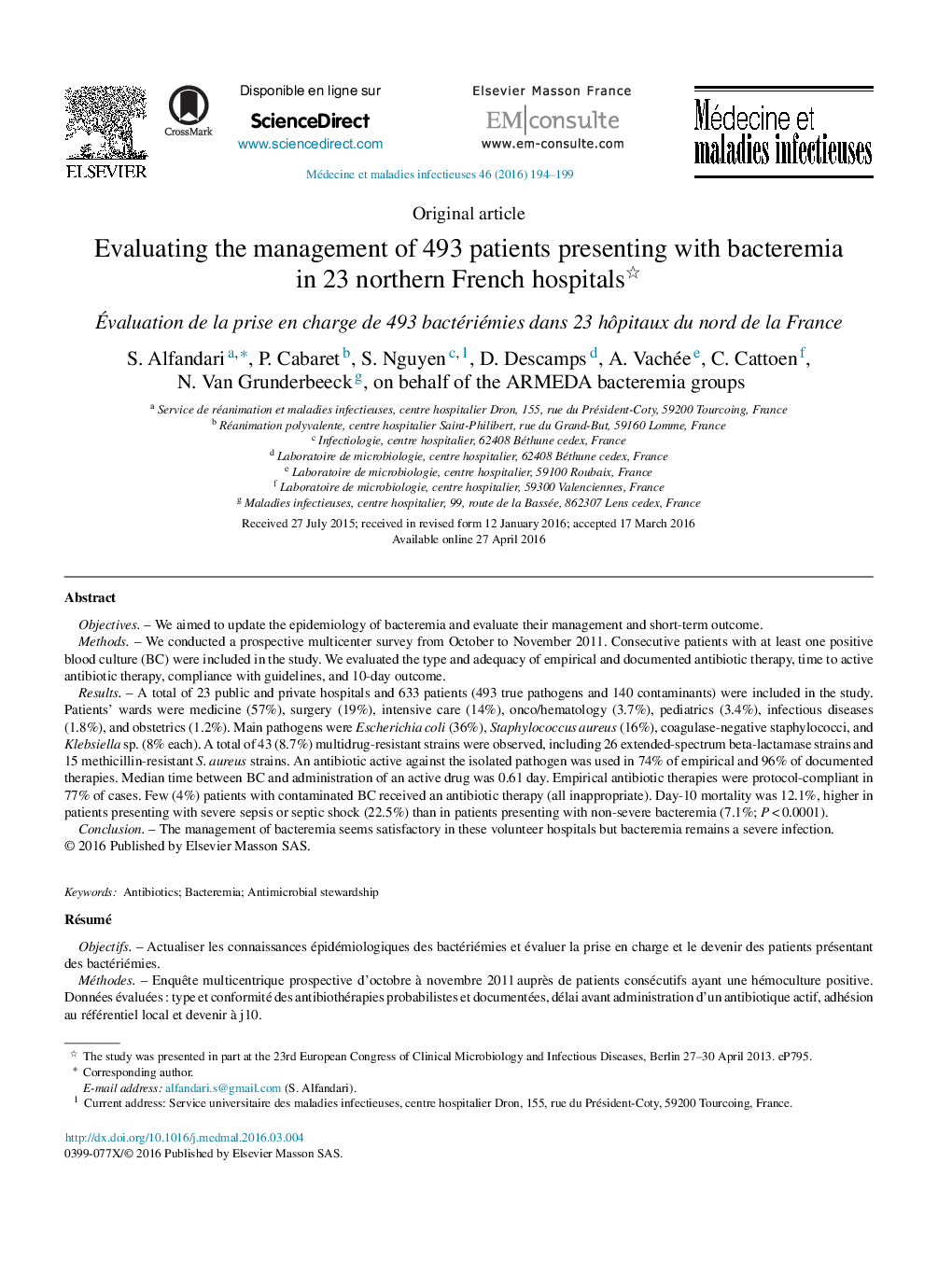| کد مقاله | کد نشریه | سال انتشار | مقاله انگلیسی | نسخه تمام متن |
|---|---|---|---|---|
| 3412278 | 1224220 | 2016 | 6 صفحه PDF | دانلود رایگان |
ObjectivesWe aimed to update the epidemiology of bacteremia and evaluate their management and short-term outcome.MethodsWe conducted a prospective multicenter survey from October to November 2011. Consecutive patients with at least one positive blood culture (BC) were included in the study. We evaluated the type and adequacy of empirical and documented antibiotic therapy, time to active antibiotic therapy, compliance with guidelines, and 10-day outcome.ResultsA total of 23 public and private hospitals and 633 patients (493 true pathogens and 140 contaminants) were included in the study. Patients’ wards were medicine (57%), surgery (19%), intensive care (14%), onco/hematology (3.7%), pediatrics (3.4%), infectious diseases (1.8%), and obstetrics (1.2%). Main pathogens were Escherichia coli (36%), Staphylococcus aureus (16%), coagulase-negative staphylococci, and Klebsiella sp. (8% each). A total of 43 (8.7%) multidrug-resistant strains were observed, including 26 extended-spectrum beta-lactamase strains and 15 methicillin-resistant S. aureus strains. An antibiotic active against the isolated pathogen was used in 74% of empirical and 96% of documented therapies. Median time between BC and administration of an active drug was 0.61 day. Empirical antibiotic therapies were protocol-compliant in 77% of cases. Few (4%) patients with contaminated BC received an antibiotic therapy (all inappropriate). Day-10 mortality was 12.1%, higher in patients presenting with severe sepsis or septic shock (22.5%) than in patients presenting with non-severe bacteremia (7.1%; P < 0.0001).ConclusionThe management of bacteremia seems satisfactory in these volunteer hospitals but bacteremia remains a severe infection.
RésuméObjectifsActualiser les connaissances épidémiologiques des bactériémies et évaluer la prise en charge et le devenir des patients présentant des bactériémies.MéthodesEnquête multicentrique prospective d’octobre à novembre 2011 auprès de patients consécutifs ayant une hémoculture positive. Données évaluées : type et conformité des antibiothérapies probabilistes et documentées, délai avant administration d’un antibiotique actif, adhésion au référentiel local et devenir à j10.RésultatsVingt-trois établissements publics et privés et 633 patients ont été inclus, dont 493 patients avec un pathogène et 139 un contaminant. Les patients venaient des services de médecine (57 %), chirurgie (19 %), réanimation (14 %), pédiatrie (3,4 %), onco-hématologie (3,7 %), infectiologie (1,8 %) et obstétrique (1,2 %). Principaux pathogènes : Escherichia coli (34 %), Staphylococcus aureus (16 %), staphylocoque à coagulase négative et Klebsiella sp. (8 % chacun). Il y avait 43 (8,7 %) BMR, dont 26 BLSE et 15 SARM. Un antibiotique actif a été observé dans 74 % des cas en probabiliste et 96 % en documenté. Le délai médian entre hémoculture et 1er antibiotique actif était de 0,61 jours. L’antibiothérapie probabiliste était conforme au référentiel local dans 77 % des cas. Seules 4 % des contaminations ont été traitées. La mortalité à j10 était de 12,1 %, plus élevée en cas de sepsis grave ou de choc septique (22,5 %) que pour les bactériémies simples (7,1 % ; p < 0,0001).ConclusionLa prise en charge initiale des bactériémies dans ces établissements volontaires semble correcte mais les bactériémies restent des infections sévères.
Journal: Médecine et Maladies Infectieuses - Volume 46, Issue 4, June 2016, Pages 194–199
